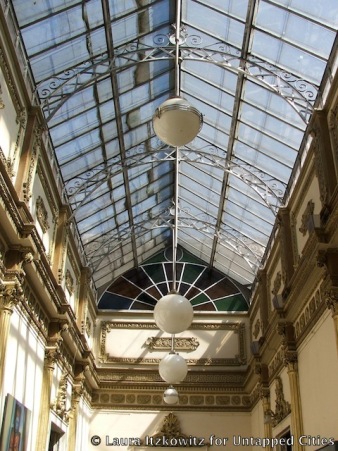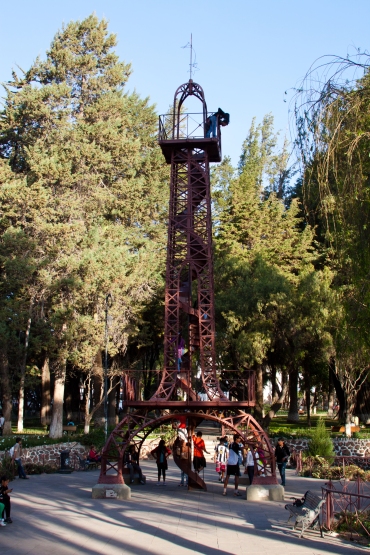90 lat temu zmarł jeden z najbardziej znanych inżynierów i architektów na świecie – Gustave Eiffel (05 XII 1832 – 27 XII 1923), twórca słynnego projektu Wieży Eiffla, zbudowanej w 1889 w Paryżu i Statuy Wolności w Nowym Jorku z 1886 roku.
Któż by jednak spodziewał się znaleźć budowle zaprojektowane przez twórcę Wieży Eiffla, w Boliwii ?
90 years ago died one of the most word famous engineers and architects – Gustave Eiffel (5 December 1832 – 27 December 1923), the best known for the Eiffel Tower, built for the 1889 Universal Exposition in Paris and Statue of Liberty in New York (1886).
But, who would have expected to find a building designed by the same man who created the Eiffel Tower, in Bolivia?
Cóż, sama widziałam komiczna kopię Statuy Wolności w Santa Cruz, ale aż do wczoraj nie miałam zielonego pojęcia o “prawdziwych’ dziełach francuskiego architekta w tym Wielonarodowym kraju. Podczas poszukiwań w ‘przestworzach’ Internetu okazało się, że w całej Ameryce Południowej istnieje wiele budowli projektu Eiffela – większość z nich w Chile i Peru, ale także w Meksyku, Argentynie, Puerto Rico oraz w Boliwii.
Well, I’ve seen a poor copy of the Statue of Liberty in Santa Cruz, but until yesterday I didn’t know about ‘real’ works by French architect in this Andean country. After a small research it appears that there are numerous buildings and constructions in South America, made by the genius of Eiffel – most of them in Chile and Peru, but also in Mexico, Argentina, Puerto Rico and in Bolivia.
Jedna z nich stoi dumnie w stolicy La Paz , witając codziennie tysiące turystów oraz miejscowych podróżnych. To dzisiejszy Dworzec Autobusowy ‘Estacion de Buses’, zbudowany ze stali. Wiadomo, że jego metalowe elementy zostały wyprodukowane we Francji, a następnie przetransportowane do Boliwii. Brzmi to niewiarygodnie, prawda?
One of them stands proudly in capital of La Paz, greeting daily thousands of visitors and commuters. It is today’s Bus Station, built of steel. Unfortunately, I couldn’t find much information about this striking building, but it is known that the metal elements of the construction were first produced in France and then transported to Bolivia. Sounds incredible, isn’t it?

fot. Wikipedia
Konstrukcja metalowa dawnego dworca kolejowego w La Paz została sfinansowana przez Spółkę “Bolivia Railway Company“. Budowę dworca w latach 1913-17 nadzorował konstruktor kataloński Miguel Nogué. Przez przeszklony luk w elewacji głównej można zobaczyć przestrzeń wewnętrzną z dwuspadowa metalową rama, podtrzymującą dach.
The metallic structure that shelters the old Raliway Station in La Paz, financed by ‘Bolivia Raliway Company’, was built between 1913 – 1917. It was in fact designed by Gustave A. Eiffel and built by the Catalan constructor Miguel Nogué. The original facade allows to see through its glazed arch the interior space with gable roof, highlighting the majestic metal frame brought from Pittsburg.

fot. Tranvias de La Paz
Od 1925 roku w budynku mieścił się Urząd Celny, a w 1980 r. został on przebudowany i dostosowany do potrzeb Dworca Autobusowego. Co roku, 16 listopada ta majestatyczna budowla obchodzi swoje “urodziny”, celebrowane Msza Święta w głównej nawie dworca.
In 1925 it was used as Customs and in 1980 the property was adapted and remodeled as a Bus Terminal. The Bus Terminal , as we know it today, celebrates its ‘birthday’ on every November 16 th, with a Mass and offering in the central nave.
Muszę przyznać, że nie widziałam tego budynku na własne oczy (do La Paz przyleciałam samolotem), więc nie mogę wiele powiedzieć o jego architekturze, ale fasada przypomniała mi Dworzec Atocha (1892) w Madrycie, który został zbudowany w czasach odnowy stylu kutego żelaza przez Alberto de Palacio Elissagne, przy współpracy z Gustavem Eiffelem.
I must admit, I haven’t seen this building with my own eyes (I came to La Paz by air), so I can’t say much about its architecture, but the outside with main entrance reminded me of Atocha Train Station (1892) in Madrid, that was built in a times of a wrought iron renewal style by Alberto de Palacio Elissagne, who collaborated with Gustave Eiffel. So, there is some connection!
~
Jedną z najbardziej uderzających rzeczy w mieście La Paz jest jego europejska architektura, która dziś często popada w ruinę. Przypomina ona podróżnym o bogatej historii kolonialnej Boliwii. Trudno jest jednak ogarnąć i uporządkować to zagmatwane połączenie wielu stylów architektonicznych , które nawarstwiały się w ciągu prawie dwustu lat boliwijskiej panstwowosci.*
One of the most striking things about the city of La Paz is its European architecture that’s often crumbling in disrepair. It immediately reminds visitors of Bolivia’s colonial history. Yet, as an outsider looking in, it’s hard to sort through the overwhelming combination of architectural styles that have collided over the course of nearly two hundred years of Bolivian independence.*
Wzdłuż jednej z reprezentacyjnych ulic La Paz ‘El Prado’, wśród nowszych (ale bardziej zdewastowanych) obiektów możemy zobaczyć prawdziwe klejnot -odrestaurowany pałac z XIX wieku (jeden z czterech zachowanych), ze szklanym dachem i witrażami zaprojektowanych przez samego Gustava Eiffela.
Along one of the representative streets of La Paz ‘El Prado’, among newer (but more devastated) buildings we could see a real jewel – a restored 19th-century mansion (only one of four left on the Prado) with a glass roof and stained-glass panels designed by mentioned Gustave Eiffel.

fot. laura Itzkowitz

Pałac został zbudowany ponad sto lat temu jako rezydencja arystokratycznego rodu, ale dziś mieści się w nim Muzeum Sztuki Współczesnej (Museo de la Arte Contemporanea).
Wikipedia wymienia jeszcze jeden budynek zaprojektowany przez wielkiego inzyniera w La Paz – “Gas works” z 1873 (Fabrica oraz Puente?). Ale nie znalazłam żadnych informacji na jego temat.
The mansion was built over one hundred years ago as a home for important aristocratic families but today it houses the Museo de Arte Contemporaneo.
Wikipedia lists one more building designed by the great architect in La Paz – ‘Gasworks‘ from 1873 (Puente and Fabrica?). But I haven’t find any information about it.
~
Największym zaskoczeniem była dla mnie natomiast informacja, iż śmieszna kopia (jak myślałam) Wieży Eiffla, która stoi w innej boliwijskiej stolicy – Sucre, jest w rzeczywistości prawdziwa! Zaprojektowana przez tego samego człowieka, który stworzył paryski pomnik! Co prawda, moja koleżanka Ester cos mi tam wspominała, ale ja na widok zardzewiałej konstrukcji, służącej jako plac zabaw dla dzieciaków i romantyczne tło dla zakochanych miast, jakoś nie chciałam w to wierzyć.
The biggest surprise was for me, however, to find out that this funny little copy (as I thought) of the Eiffel Tower, that stands in other Bolivian capital of Sucre, is in fact a real thing! Designed by the same man who created Parisian monument! To be honest, my friend Ester mention something about it, but I just couldn’t believe that this rusty construction, used as a monkey bars by local kids and a romantic background for loving couples, can be of any importance.

Żelazna struktura”Torre Eiffel”, dzis położona jest w samym sercu Parku Bolivar. Mimo powszechnej opinii (o tak!), wieza ta nie jest replika paryskiej- przeciwnie, jest tak wyjatkowa, jak jej francuska siostra. Boliwijska wieża została zamówiona przez Instituto Médico Sucre jako Obserwatorium Meteorologiczne. Jej konstrukcja metalowa wyprodukowana zostala we Francji i zlozona w Sucre 1909 roku.
The ‘Torre Eiffel‘, as it’s called here, is an iron structure, located in the heart of the ‘Bolivar Park’. On the contrary to what many think (oh yes), this tower isn’t a replica of the Parisian Tower, as they are very different in design, being as unique as its French sister. Tower was ordered by Instituto Médico Sucre to serve as a Meteorological Observatory. It was ‘put together’ from metal structures produced in France and put together one year later in 1909.
Po 16 latach, Torre Eiffel została przeniesiona do Parque Bolivar, z okazji 100-lecia istnienia Republiki Boliwii, gdzie stoi do dziś.
I kto by pomyślał, że te niepozorne dzis miejsca mają taką ciekawą historię?
After 16 years, the ‘Torre Eiffel’ was moved to ‘Parque Bolívar’, as a tribute to the 100 years anniversary of the Republic of Bolivia, where it stands til today.
Who would have thought that these places have such an interesting history? (Shame on you, Danu…)
Źródła/Sources: Torre Eiffel Sucre, Gustave Eiffel (Wikipedia), Museo de Arte Contemporaneo (Laura Itzkowitz* for Untapped Cities) & photographs of old La Paz (Tranvias de La Paz).

